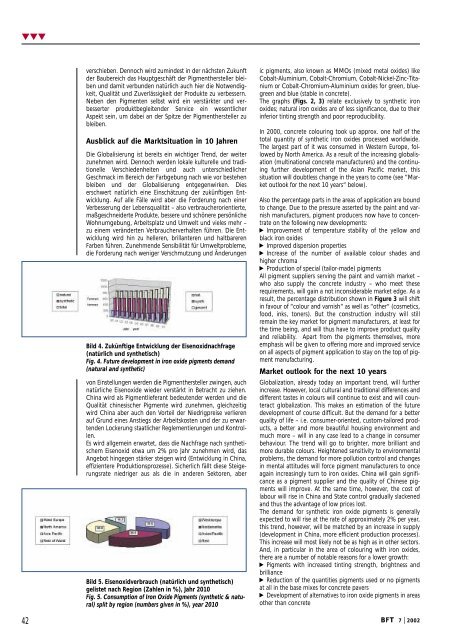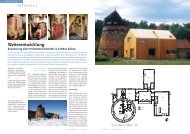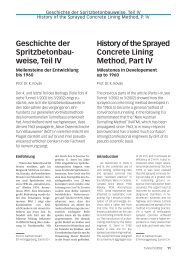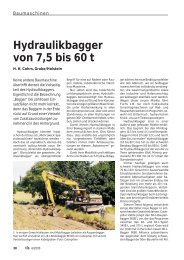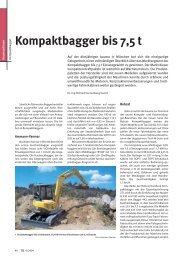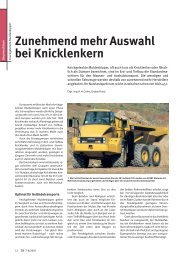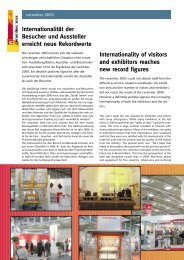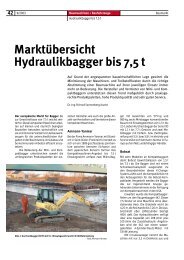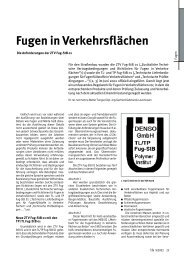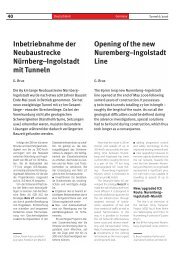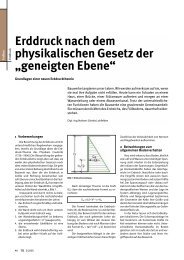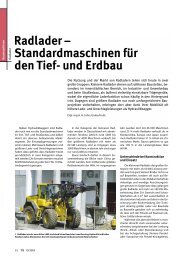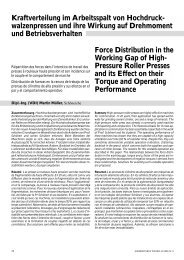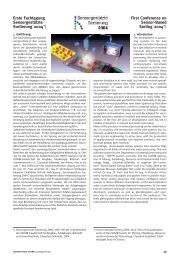Pigmentierung von Zement und/oder kalkgebundenen ... - Bauverlag
Pigmentierung von Zement und/oder kalkgebundenen ... - Bauverlag
Pigmentierung von Zement und/oder kalkgebundenen ... - Bauverlag
Sie wollen auch ein ePaper? Erhöhen Sie die Reichweite Ihrer Titel.
YUMPU macht aus Druck-PDFs automatisch weboptimierte ePaper, die Google liebt.
▼▼▼<br />
42<br />
verschieben. Dennoch wird zumindest in der nächsten Zukunft<br />
der Baubereich das Hauptgeschäft der Pigmenthersteller bleiben<br />
<strong>und</strong> damit verb<strong>und</strong>en natürlich auch hier die Notwendigkeit,<br />
Qualität <strong>und</strong> Zuverlässigkeit der Produkte zu verbessern.<br />
Neben den Pigmenten selbst wird ein verstärkter <strong>und</strong> verbesserter<br />
produktbegleitender Service ein wesentlicher<br />
Aspekt sein, um dabei an der Spitze der Pigmenthersteller zu<br />
bleiben.<br />
Ausblick auf die Marktsituation in 10 Jahren<br />
Die Globalisierung ist bereits ein wichtiger Trend, der weiter<br />
zunehmen wird. Dennoch werden lokale kulturelle <strong>und</strong> traditionelle<br />
Verschiedenheiten <strong>und</strong> auch unterschiedlicher<br />
Geschmack im Bereich der Farbgebung nach wie vor bestehen<br />
bleiben <strong>und</strong> der Globalisierung entgegenwirken. Dies<br />
erschwert natürlich eine Einschätzung der zukünftigen Entwicklung.<br />
Auf alle Fälle wird aber die Forderung nach einer<br />
Verbesserung der Lebensqualität – also verbraucherorientierte,<br />
maßgeschneiderte Produkte, bessere <strong>und</strong> schönere persönliche<br />
Wohnumgebung, Arbeitsplatz <strong>und</strong> Umwelt <strong>und</strong> vieles mehr –<br />
zu einem veränderten Verbraucherverhalten führen. Die Entwicklung<br />
wird hin zu helleren, brillanteren <strong>und</strong> haltbareren<br />
Farben führen. Zunehmende Sensibilität für Umweltprobleme,<br />
die Forderung nach weniger Verschmutzung <strong>und</strong> Änderungen<br />
Bild 4. Zukünftige Entwicklung der Eisenoxidnachfrage<br />
(natürlich <strong>und</strong> synthetisch)<br />
Fig. 4. Future development in iron oxide pigments demand<br />
(natural and synthetic)<br />
<strong>von</strong> Einstellungen werden die Pigmenthersteller zwingen, auch<br />
natürliche Eisenoxide wieder verstärkt in Betracht zu ziehen.<br />
China wird als Pigmentlieferant bedeutender werden <strong>und</strong> die<br />
Qualität chinesischer Pigmente wird zunehmen, gleichzeitig<br />
wird China aber auch den Vorteil der Niedrigpreise verlieren<br />
auf Gr<strong>und</strong> eines Anstiegs der Arbeitskosten <strong>und</strong> der zu erwartenden<br />
Lockerung staatlicher Reglementierungen <strong>und</strong> Kontrollen.<br />
Es wird allgemein erwartet, dass die Nachfrage nach synthetischem<br />
Eisenoxid etwa um 2% pro Jahr zunehmen wird, das<br />
Angebot hingegen stärker steigen wird (Entwicklung in China,<br />
effizientere Produktionsprozesse). Sicherlich fällt diese Steigerungsrate<br />
niedriger aus als die in anderen Sektoren, aber<br />
Bild 5. Eisenoxidverbrauch (natürlich <strong>und</strong> synthetisch)<br />
gelistet nach Region (Zahlen in %), Jahr 2010<br />
Fig. 5. Consumption of Iron Oxide Pigments (synthetic & natural)<br />
split by region (numbers given in %), year 2010<br />
ic pigments, also known as MMOs (mixed metal oxides) like<br />
Cobalt-Aluminium, Cobalt-Chromium, Cobalt-Nickel-Zinc-Titanium<br />
or Cobalt-Chromium-Aluminium oxides for green, bluegreen<br />
and blue (stable in concrete).<br />
The graphs (Figs. 2, 3) relate exclusively to synthetic iron<br />
oxides; natural iron oxides are of less significance, due to their<br />
inferior tinting strength and poor reproducibility.<br />
In 2000, concrete colouring took up approx. one half of the<br />
total quantity of synthetic iron oxides processed worldwide.<br />
The largest part of it was consumed in Western Europe, followed<br />
by North America. As a result of the increasing globalisation<br />
(multinational concrete manufacturers) and the continuing<br />
further development of the Asian Pacific market, this<br />
situation will doubtless change in the years to come (see “Market<br />
outlook for the next 10 years“ below).<br />
Also the percentage parts in the areas of application are bo<strong>und</strong><br />
to change. Due to the pressure asserted by the paint and varnish<br />
manufacturers, pigment producers now have to concentrate<br />
on the following new developments:<br />
n Improvement of temperature stability of the yellow and<br />
black iron oxides<br />
n Improved dispersion properties<br />
n Increase of the number of available colour shades and<br />
higher chroma<br />
n Production of special (tailor-made) pigments<br />
All pigment suppliers serving the paint and varnish market –<br />
who also supply the concrete industry – who meet these<br />
requirements, will gain a not inconsiderable market edge. As a<br />
result, the percentage distribution shown in Figure 3 will shift<br />
in favour of “colour and varnish“ as well as “other“ (cosmetics,<br />
food, inks, toners). But the construction industry will still<br />
remain the key market for pigment manufacturers, at least for<br />
the time being, and will thus have to improve product quality<br />
and reliability. Apart from the pigments themselves, more<br />
emphasis will be given to offering more and improved service<br />
on all aspects of pigment application to stay on the top of pigment<br />
manufacturing.<br />
Market outlook for the next 10 years<br />
Globalization, already today an important trend, will further<br />
increase. However, local cultural and traditional differences and<br />
different tastes in colours will continue to exist and will counteract<br />
globalization. This makes an estimation of the future<br />
development of course difficult. But the demand for a better<br />
quality of life – i.e. consumer-oriented, custom-tailored products,<br />
a better and more beautiful housing environment and<br />
much more – will in any case lead to a change in consumer<br />
behaviour. The trend will go to brighter, more brilliant and<br />
more durable colours. Heightened sensitivity to environmental<br />
problems, the demand for more pollution control and changes<br />
in mental attitudes will force pigment manufacturers to once<br />
again increasingly turn to iron oxides. China will gain significance<br />
as a pigment supplier and the quality of Chinese pigments<br />
will improve. At the same time, however, the cost of<br />
labour will rise in China and State control gradually slackened<br />
and thus the advantage of low prices lost.<br />
The demand for synthetic iron oxide pigments is generally<br />
expected to will rise at the rate of approximately 2% per year,<br />
this trend, however, will be matched by an increase in supply<br />
(development in China, more efficient production processes).<br />
This increase will most likely not be as high as in other sectors.<br />
And, in particular in the area of colouring with iron oxides,<br />
there are a number of notable reasons for a lower growth:<br />
n Pigments with increased tinting strength, brightness and<br />
brilliance<br />
n Reduction of the quantities pigments used or no pigments<br />
at all in the base mixes for concrete pavers<br />
n Development of alternatives to iron oxide pigments in areas<br />
other than concrete<br />
BFT 7 | 2002


